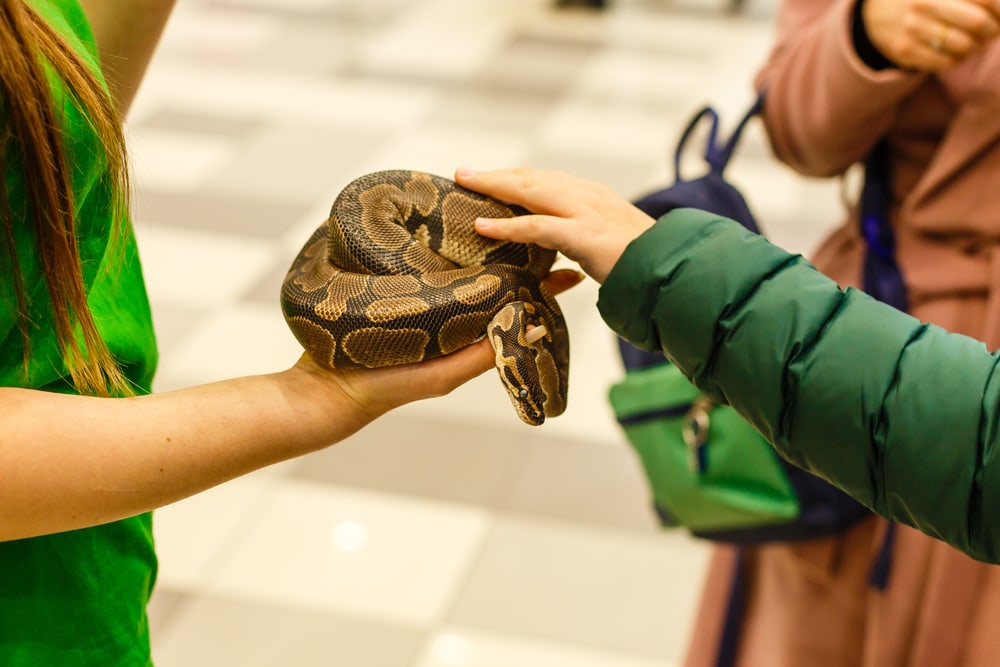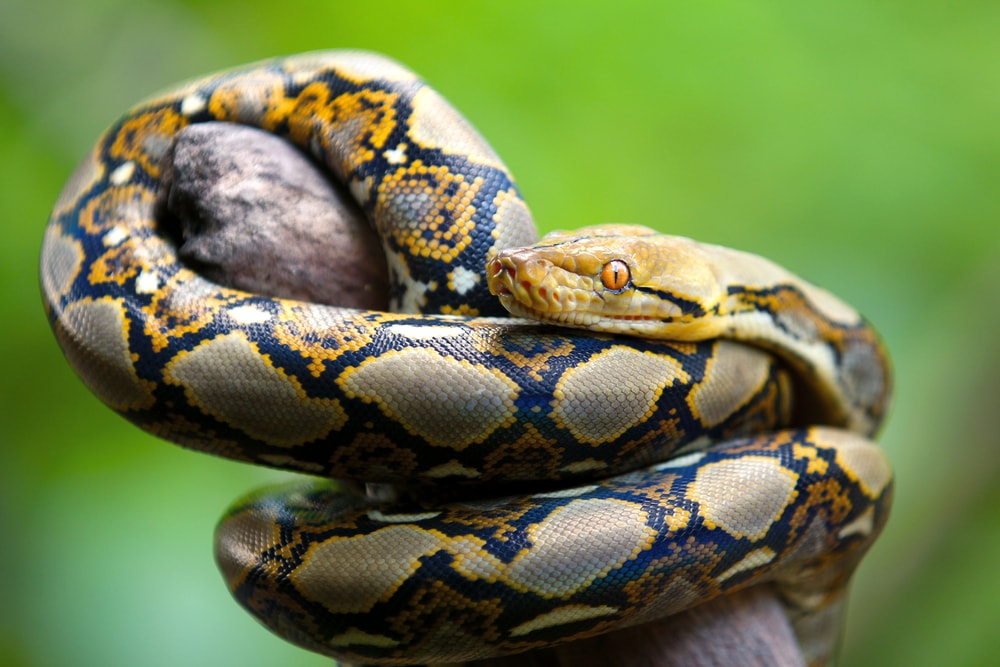Outforia Quicktake: Key Takeaways
- The reticulated python is the longest snake alive, with adults reaching up to 28.5 feet (8.6 meters) in length.
- They are native to the southern regions of Asia and primarily inhabit wetlands and low-lying rainforests.
- Reticulated pythons have a diverse diet consisting of mammals and birds, including bats, shrews, deer, and birds.
- They are not considered endangered or threatened, but face risks from human hunters and climate change.
- Invasive populations have been found in Florida, where they thrive in the Everglades due to a lack of natural predators and ideal habitat conditions.
Movies like Anaconda have fueled nightmares of massive snakes. Thankfully, the largest snakes in existence all went extinct, along with the dinosaurs. Still, that doesn’t mean there aren’t huge snakes out there.
The heaviest snake in the world might be the green anaconda. However, the longest snake is the reticulated python. These snakes have reportedly been sighted at nearly 30 feet (10 meters) in length. While they don’t have a wide native range, they invade other parts of the world.

share this image on your site
<a href="https://outforia.com/reticulated-python/"><img style="width:100%;" src="https://outforia.com/wp-content/uploads/2022/09/reticulated-python-inforgraphic-0922-683x1024.jpg"></a><br>reticulated python <a href="https://outforia.com">Outforia</a>Reticulated Python (Malayopython reticulatus)

The reticulated python is the longest snake alive today. Adults can easily reach 16 feet (4.8 meters) in length.
In the wild, it isn’t uncommon for them to reach over 20 feet (6 meters). In a zoo setting, the longest reticulated python grew to a staggering 28.5 feet (8.6 meters)!
Their color pattern contains diamond-shaped spots. The pattern connects to itself like a spiderweb. This network of lines is where the python gets its name. The network is usually black or dark brown. The rest of the python is light brown or yellow.
On the tip of their snout, reticulated pythons have heat-sensing organs. These pits create an infrared image of their surroundings. In addition to a keen sense of smell, it helps the python hunt in low-light conditions.
Inside their mouth are sharp, backward-facing fangs. These fangs don’t deliver poison. Instead, they make it nearly impossible for prey to escape once the python has latched onto them.
Native Range and Ideal Habitat

By I, Accipiter / CC BY-SA 3.0 / Wikimedia commons
Reticulated pythons are originally from the southern regions of Asia. Myanmar, Malaysia, and the Philippines are home to these large snakes.
Rainforests are the perfect habitat for reticulated pythons. They prefer the wetlands and low-lying rainforests of the southern Asian regions.
Temperature-wise, they need a steady range between 24 and 34 degrees Celsius. Any more or less than this can cause them to be unable to reproduce or simply kill them.
Unlike some other snakes, reticulated pythons can adapt to different habitats fairly well. They’ve been found outside of the rainforest and swamplands they call home. Farmlands are a great spot for them, and they’ve even been found in urban environments.
Diet and Behaviors
Most of their prey consists of mammals and birds. Bats, shrews, deer, and birds are common prey. Reticulated pythons have even been known to eat sun bears!
These pythons hunt with their sense of smell and the heat-sensing organs on their snout. They can see fairly well but rely on their other sense more to hunt.
Once prey is located, the snake strikes and grips the prey with its fangs. Once they seize their prey, they coil their muscular bodies around it and squeeze.
Pythons are constrictor snakes. They have large fangs but no venom. To kill, they rely on crushing and suffocating prey with their bodies.
Reticulated pythons are both active and ambush hunters. Their pattern easily blends into the rainforest floor. It gives them an edge when they want to hide and wait on prey to come too close.
Despite this, they’re also known to actively search for and attack prey.
Not many animals prey on reticulated pythons. Juveniles are fairly vulnerable to birds of prey and predators. They grow quickly, though. Most predators can’t take on a sexually mature reticulated python.
Large predators like crocodiles and tigers are the only animals known to feed on adults. This is a rare occurrence because an adult python can turn the tables on them.
You may also like: 25 Amazing Types of Snakes (Photos, Fun Facts & More!)
Reproduction and Lifecycle

Reticulated pythons can live for over twenty years. They usually reach sexual maturity between two and four years. However, length means more than age for these snakes.
Males typically breed after reaching a length between 7 and 9 feet (2.1 to 2.9 meters). Females typically breed after reaching 11 feet (3.3 meters) in length.
An average female will lay 25 to 80 eggs at a time. They take between 80 and 90 days to incubate. The mother doesn’t leave the nest during incubation. Instead, she guards it and keeps it warm.
If it gets too cool, the mother vibrates her muscles to produce heat. This is her way of keeping the eggs warm.
After birth, the baby snakes are on their own. They get no support from their parents and are completely independent immediately.
It’s uncommon, but parthenogenesis has been observed in captive reticulated pythons. Parthenogenesis is when an animal reproduces without a male.
Essentially, female reticulated pythons have been known to lay eggs without breeding. Its one-way nature has enabled them to reproduce, even if no males are present.
Environmental Role

Reticulated pythons are an indicator of a healthy ecosystem. They keep rodent populations in check. This is especially important around farmland where rodent populations could explode.
Generally, an adult reticulated python sits at or near the top of the food web in its environment.
You may also like: 12 Different Types of Ecosystems and Why They Are Important
Human Interactions

There’s a long history between reticulated pythons and humans.
Globally, reticulated pythons are the most-hunted snake. This is because their skin can bring in quite a bit of money. The patterns on their back are considered beautiful, and since they’re so large, there’s a lot of skin to sell.
In some places, these snakes are hunted for food and are a valuable resource because of their large size.
Aside from hunting, reticulated pythons face another threat from humans. The exotic pet trade encourages many pythons to be caught and sold worldwide. Some people breed these snakes in hopes of developing new colors and patterns.
Some farmers want them around simply to help keep rodents out of their crops.
Unfortunately, these pythons are often killed because of how close they get to humans. They’re often found in urban environments and seem to do well there. They’ve gained a reputation as being aggressive. Consistent handling of pets and in zoos seems to keep that instinct from popping up, though.
Attacks on humans are uncommon in places where humans and pythons share space. Reticulated pythons are huge snakes and feed on mammals. This means that people can sometimes be seen as prey for them.
Population Threats

Reticulated pythons are not on any endangered or threatened lists. Their skin is regulated internationally to try to help regulate its trade. The largest threats to these snakes are human hunters and potentially climate change.
Overall, reticulated pythons have steady populations in areas they are native. Even urban populations seem to stay healthy. This is probably due to their ability to lay large clutches of eggs once per year. Lack of natural predators and care while still in the egg also contribute to their stability.
You may also like: 10 Most Venomous Australian Snakes In The World
Reticulated Pythons As An Invasive Species

Reticulated pythons spread worldwide thanks to exotic pet trade and their inclusion in zoos. Unfortunately, not everyone who buys one is a good owner or keeps it forever. Sometimes, pets escape. Other times, owners just abandon unwanted pets. This is especially when their snake gets much larger than they thought it would.
Florida is quite a hot spot for invasive species thanks to an exotic pet trade and a warm, humid climate. The wetlands of Florida are the perfect environment for all kinds of reptiles.
Along with the Burmese python, reticulated pythons have made their way to the Sunshine State. They’ve mostly taken up residence in the Everglades. They are only stopped from going north by cool winters.
American alligators aren’t nearly as big as the crocodiles in the reticulated python’s native range. Florida has no natural predators for adult reticulated pythons. This and an ideal habitat have led to them thriving inside the state.
You may also like: 50+ Snakes In Florida: ID Guide With Facts, Photos, Chart And More
How Do You Tame a Reticulated Python?

Trying to tame an adult reticulated python is foolish, and you won’t be convincing me otherwise. It is possible, though, with juvenile snakes.
Generally, you want to handle the snake often to get it used to people. While I don’t recommend it, you can view an extensive explanation on taming reticulated pythons.
A synopsis of the article in question. You mainly want to handle the snake often and get it used to being touched. Snack hooks are useful for helping control the animal. With babies, you want to let them slither through your fingers a lot.
Never handle large snakes on your own.
You may also like: Do Snakes Have Bones? Flexible Danger Noodles And Their Spectacular Skeletons
Reticulated Python FAQs

How dangerous are reticulated pythons?
In most cases, reticulated pythons aren’t dangerous to humans. Even in urban environments, attacks by snakes are very uncommon.
That being said, these snakes could be considered very dangerous. If one did decide to coil itself around you while you’re alone, you’d be hard-pressed to fight it off.
What’s the difference between reticulated pythons and Burmese pythons?
Burmese and reticulated pythons are two distinct species of snake. The Burmese pythons don’t reach the same lengths or weights as the reticulated. They also have very different color patterns.
Can reticulated pythons be pets?
You can keep a reticulated python as a pet. Beginner snake owners should absolutely not keep a reticulated python. You can tame them, but they still have aggressive tendencies.
They need huge enclosures to fit their massive bodies comfortably. I recommend not having one as a pet.
Can a reticulated python beat an anaconda in a fight?
You can look here for a breakdown of the fight, but I’ll throw my two cents in for fun.
The anaconda wins. And it isn’t a close fight. Fully grown, an anaconda weighs more than twice what the reticulated python does. It’s much thicker, stronger, and faster.
What is the biggest thing eaten by a reticulated python?
The biggest thing we know a reticulated python has eaten is a sun bear. Unfortunately, the one it ate was mostly starved and only weighed around fifty pounds (22.6 kg).
That doesn’t mean it’s the biggest thing they can eat, though. Pythons in the Everglades have tried eating adult alligators. However, the one we know about ended up bursting open.
More from Outforia
Learn more about these other amazing snake species!










